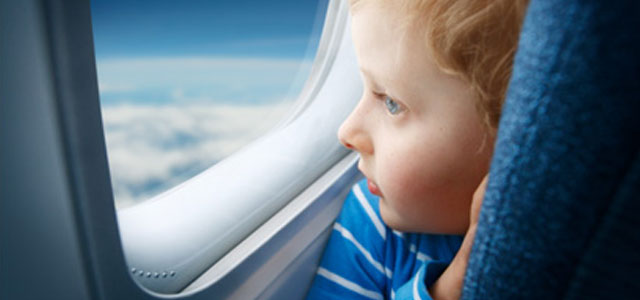 Parents go to great lengths to keep children safe at home and on the road. But what about in the air? When you’re traveling by airplane, an approved child restraint system (CRS) is the only way to make sure your little one will be safe in the event of turbulence or an emergency.
Parents go to great lengths to keep children safe at home and on the road. But what about in the air? When you’re traveling by airplane, an approved child restraint system (CRS) is the only way to make sure your little one will be safe in the event of turbulence or an emergency.
Turbulence is air movement that normally cannot be seen and often occurs unexpectedly. It can be created by many different conditions, including atmospheric pressure, jet streams, air around mountains, cold or warm weather fronts or thunderstorms. Turbulence can even occur when the sky appears to be clear.
The Federal Aviation Administration (FAA) strongly urges you to secure your child in an appropriate restraint based on weight and size. Turbulence can happen with little or no warning. And when it does, the safest place for your child is in a CRS, not in an adult’s lap. Your arms just aren’t capable of holding your child securely, especially when turbulence is unexpected. Keeping your child in a CRS for the duration of the flight is the smart and right thing to do so that everyone in your family arrives safely at your destination.
Make sure you’re cleared for take-off
Make sure your CRS is government approved and has “This restraint is certified for use in motor vehicles and aircraft” printed on it. Otherwise, you may be asked to check the CRS as baggage.
- Measure the width of your CRS. It should fit in most airplane seats if it is no wider than 16 inches.
- Ask your airline for a discounted fare. Many airlines now offer discounts of up to 50 percent for children less than two years of age. Purchasing a ticket for your child is the only way to guarantee that you will be able to use a CRS.
- Reserve adjoining seats. A CRS must be placed in a window seat so it will not block the escape path in an emergency. A CRS may not be placed in an exit row.
- If you do not purchase a ticket for your child, ask if your airline will allow you to use an empty seat. If your airline’s policy allows this, avoid the busiest days and times to increase the likelihood of finding an empty seat next to you.
- Ask your airline if they can provide a CRS for your child. If so, you may not be permitted to bring your own CRS on board and may need to check it as baggage.
- Arrange for your airline to assist you if you need help making a connecting flight. Carrying a CRS, a child and luggage through a busy airport can be challenging.
- Pack a bag of toys and snacks to keep your child occupied during the flight.
- And, of course, always use a CRS in your vehicle when driving to and from the airport—or anywhere!
Keep your little one safe when you’re in the air
Always follow the manufacturer’s instructions for using a CRS. Be sure that the shoulder straps are properly adjusted and fasten the airplane seat belt around the CRS as tightly as possible.
Do not place a child in a CRS designed for a smaller or larger child than indicated in the manufacturer’s instructions. The FAA recommends that a child weighing:
- Less than 20 pounds use a rear-facing CRS.
- From 20 to 40 pounds use a forward-facing CRS.
- More than 40 pounds use an airplane seat belt.
While booster seats and harness vests enhance safety in vehicles, the FAA prohibits passengers from bringing these types of devices on airplanes for use during taxi, take-off and landing. They should be checked as baggage. Also, supplemental lap restraints or “belly belts” are banned for use in both airplanes and vehicles in the United States.
It’s a good idea to bring this brochure with you when you travel. For more information, visit http://www.faa.gov/. And remember that adults should wear their seat belts at all times while on board, too, because turbulence happens!




